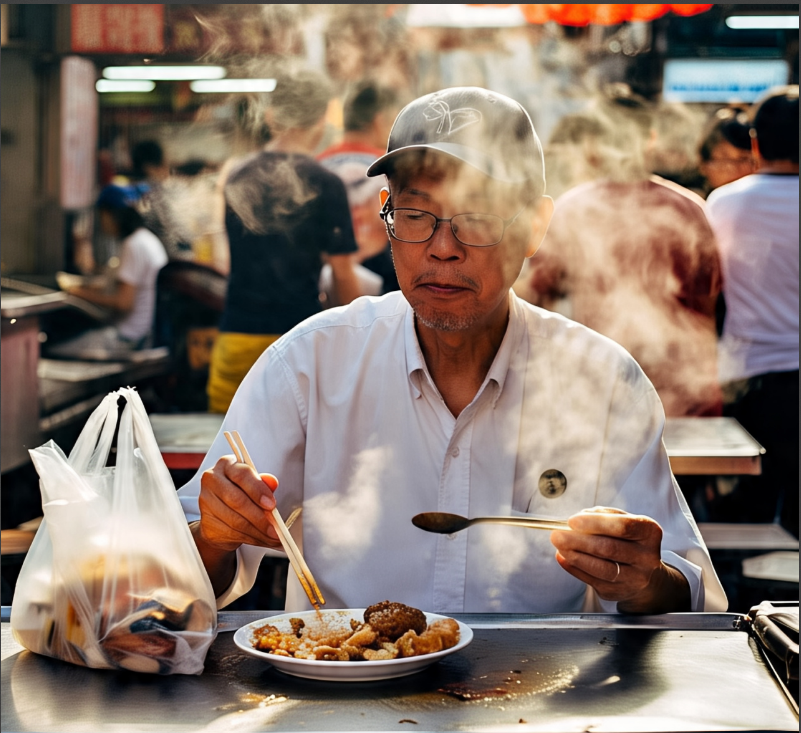Introduction to Chinatown Hawker Leftovers Consumption
In the coronary heart of many bustling cities throughout Asia, the vibrancy of Chinatown districts stands out now not only for their rich cultural historical past, but also for his or her irresistible hawker food. The avenue meals culture in Chinatowns—specially in cities like Singapore, Kuala Lumpur, and Bangkok—is legendary. From scorching satay and stir-fried noodles to aromatic dim sum and spicy soups, these hawker stalls dish out meals that entice locals and vacationers alike. However, an rising exercise referred to as Chinatown Hawker Leftovers Consumption is now gaining interest each inside the media and most of the public.
This phenomenon involves individuals consuming meals that has been left over or discarded at hawker stalls in Chinatown. It increases numerous questions about food waste, sustainability, socio-monetary inequality, hygiene, and cultural attitudes. In this newsletter, we explore the depths of this practice, from its causes and implications to the societal reaction and viable future solutions. The subject matter is controversial, but deeply related to some of these days’s maximum pressing global issues.
Understanding the Root Causes of Hawker Leftovers Consumption
At the core of Chinatown Hawker Leftovers Consumption is a hard and fast of overlapping reasons which can be monetary, cultural, and environmental in nature. Rising food fees, inflation, and the increasing disparity among economic classes have created pockets of vulnerability even in quite affluent societies. Urban poverty and homelessness are key drivers, pushing a few people to are searching for nourishment from non-conventional assets—which includes discarded hawker meals.
Moreover, in Asian cultures wherein food abundance is regularly visible as a signal of prosperity, hawker facilities often produce greater meals than is offered. This excess, as opposed to being stored or repurposed, is frequently thrown away at the quit of the day. Some locals and scavengers have recognized the ability of those leftovers—nonetheless warm and primarily untouched—as a means of surviving starvation and worry. Environmentalists additionally factor to the amazing degrees of meals waste generated each day and see leftovers intake as a shape of grassroots sustainability, albeit arguable.
Cultural Perspectives on Food Sharing and Waste
In many Asian traditions, meals holds symbolic significance past nourishment. Sharing meals is visible as a gesture of love, respect, and team spirit. However, the idea of eating meals that others have discarded consists of social stigma. Chinatown Hawker Leftovers Consumption demanding situations the bounds of these cultural norms. For a few, it is an act of desperation; for others, it represents a way to protest against food waste in a silent however powerful way.
In a few Chinatowns, together with those in Singapore or Penang, neighborhood activists and network agencies are running to eliminate this stigma. By organizing leftover meals redistribution campaigns and inspiring hawkers to donate in preference to discard, they’re changing public notion. Still, the exercise is met with blended feelings. Some view it as unsanitary or degrading, at the same time as others see it as a survival mechanism deserving of empathy and systemic help.
Health and Hygiene Concerns Related to Leftovers
The principal difficulty surrounding Chinatown Hawker Leftovers Consumption is hygiene. Hawker stalls often lack the refrigeration and sanitary controls discovered in formal restaurants. Once food sits out, specifically in warm and humid climates, it turns into a breeding floor for micro organism. For individuals eating those leftovers, the threat of foodborne illness increases substantially.
Despite those dangers, many who rely on this shape of sustenance haven’t any higher alternatives. Some practice selective consumption—selecting simplest visibly smooth or untouched meals. Others depend upon the fact that many hawker stalls throw out meals in sealed boxes or smooth wrapping. Still, with out respectable law or oversight, this remains a grey location. Public fitness experts warn against normalizing such practices, bringing up possible outbreaks and lengthy-time period health risks, in particular among already vulnerable populations.
The Environmental Argument: Reducing Food Waste
Every day, hawker facilities in Chinatown discard heaps of uneaten meals, most of which results in landfills. From an environmental perspective, Chinatown Hawker Leftovers Consumption serves as a crude however powerful shape of food recycling. It aligns with the zero-waste philosophy, imparting a 2d lifestyles to flawlessly suitable for eating meals.
Environmental activists and sustainable residing advocates argue that greater prepared methods may be taken to limit waste. For example, leftover meals can be thoroughly collected and redistributed thru non-earnings or network refrigerators. Educational campaigns also can educate hawkers better inventory control to lessen overproduction. If nicely prepared, leftovers intake can evolve from a desperate act right into a socially proper and environmentally tremendous movement.
Role of Government and Policy in Managing the Issue
Governments were sluggish to reply to the upward push of Chinatown Hawker Leftovers Consumption. In component, that is due to the sensitive nature of the topic—straddling troubles of poverty, public fitness, and dignity. Few towns have clean policies that cope with how leftovers can be handled, who can get entry to them, and underneath what situations. Most food protection laws limit the resale or distribution of prepared meals that has been served or displayed.
However, there are some effective examples. In Taiwan, rules allows food donors (which includes hawkers) to provide leftovers to certified non-profits without legal responsibility. Singapore’s National Environment Agency is exploring similar initiatives. With public pressure mounting, greater nearby governments may additionally comply with suit, providing guidance and infrastructure to cope with this complicated issue.
Voices from the Ground: The People Behind the Practice

Personal stories provide depth to the idea of Chinatown Hawker Leftovers Consumption. For instance, in Kuala Lumpur’s Petaling Street, a former mechanic named “Ah Wai” gathers leftover chook rice after stalls close. He sanitizes what he can, reheats it, and stocks it with different homeless people. “It’s better than dozing hungry,” he says.
Similarly, a few hawkers have begun quietly supporting the exercise. In Singapore’s Chinatown Complex, some stalls depart meals deliberately wrapped and placed near containers, understanding scavengers will retrieve it. While they avoid brazenly endorsing it for fear of regulatory issues, these silent gestures exhibit a shape of avenue-level compassion and resourcefulness.
Community Initiatives and Grassroots Solutions
Grassroots groups are stepping in to formalize and humanize Chinatown Hawker Leftovers Consumption. Volunteer companies in Bangkok and Hong Kong have began midnight meals distribution campaigns using surplus hawker food. These programs no longer simplest assist reduce waste however additionally provide regular food to the needy.
Community refrigerators are another modern answer. Installed in public regions near Chinatown districts, these allow hawkers to deposit secure leftovers for each person to collect. Such efforts remodel the narrative from shame to sharing. These projects additionally reduce the fitness risks with the aid of making sure meals is saved effectively and disbursed right away. With increased public education and guide, they’ve the potential to come to be fashions of city compassion.
Ethical Dilemmas and Public Perception
There’s an moral tightrope in discussing Chinatown Hawker Leftovers Consumption. On one hand, no person must should rely on discarded meals to live to tell the tale. On the opposite, meals waste is a global disaster, and people in need have to not be denied access to safe to eat sources. The moral debate regularly facilities on dignity: Is this an empowering act of sustainability, or a humiliating signal of inequality?
Public opinion stays divided. Some believe allowing leftovers consumption promotes laziness or undermines formal food assistance systems. Others argue it is a symptom of social failure, not individual desire. Bridging this divide requires open conversations, schooling, and authorities engagement that goes past judgment and makes a speciality of realistic, human-centered answers.
Future of Chinatown Hawker Leftovers Consumption
Looking beforehand, the trajectory of Chinatown Hawker Leftovers Consumption relies upon in large part on public policy, network movement, and cultural attitude shifts. If framed positively—as part of a broader meals sustainability motion—leftovers intake can evolve from a closing inn into a deliberate way of life desire. In cities wherein hawker culture is crucial to identification, related to hawkers as allies in food redistribution efforts can make a major difference.
With technological improvements, apps may be developed to connect meals donors with consumers in real-time. Regulatory modifications, like legal immunity for excellent-religion donations, ought to inspire extra hawkers to take part. Education campaigns can shift societal attitudes from shaming to helping the ones involved. Ultimately, addressing the root reasons—poverty, inequality, and overproduction—will determine whether or not this phenomenon continues as a disaster response or turns into a celebrated symbol of urban resilience.
Key Takeaways
- Urban poverty and food inflation are major drivers of hawker leftovers consumption.
- Cultural attitudes both stigmatize and enable the practice in different ways.
- Public health risks must be balanced with the benefits of reducing food waste.
- Community initiatives like food sharing programs and fridges offer safe alternatives.
- Policy change and public education are critical for long-term solutions.
Conclusion: Turning Waste into Worth
Chinatown Hawker Leftovers Consumption highlights the intersection of city starvation, meals waste, social stigma, and resilience. While the exercise might also enhance eyebrows, it’s miles rooted in genuine want and systemic gaps. Addressing it with compassion, coverage, and innovation can remodel a symbol of desperation right into a beacon of sustainability. Whether pushed via necessity, activism, or environmental challenge, the movement has the potential to reshape how cities manipulate meals and aid their most susceptible citizens.
FAQs: Chinatown Hawker Leftovers Consumption
1. Is it legal to consume hawker leftovers in Chinatown?
Laws vary by country. In some places, scavenging is not illegal but may be discouraged for public health reasons. Check local regulations.
2. Is it safe to eat leftovers from hawker stalls?
It depends on how the food was stored and how long it’s been exposed. There are risks of bacterial contamination without proper refrigeration.
3. Are there any organized efforts to redistribute hawker food?
Yes, some cities have NGOs and community programs that collect and distribute unsold food safely to those in need.
4. Why don’t hawker stalls donate the food themselves?
Many fear liability issues or lack the infrastructure for donation. In some areas, food safety laws prohibit donation of prepared food.
5. How can I support ethical food waste reduction in Chinatown?
Volunteer with or donate to local food redistribution programs, advocate for policy changes, and help destigmatize food sharing practices.
